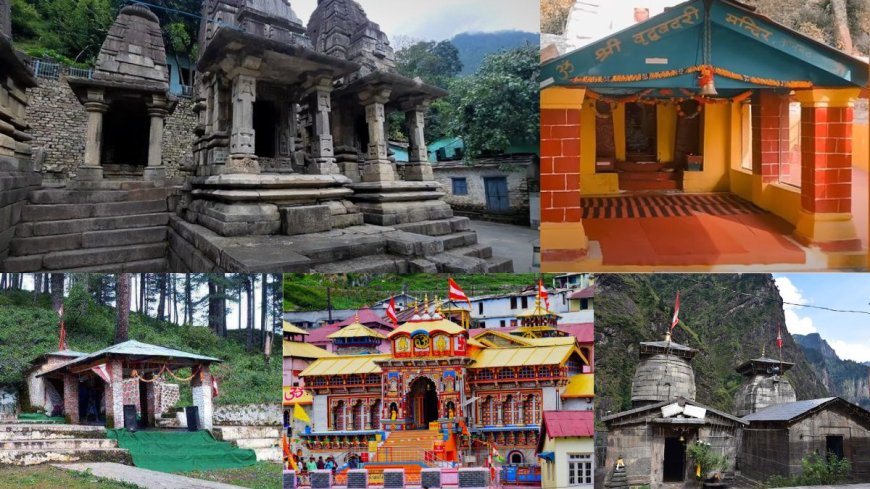The Panch Badri Tour: An Immersive Pilgrimage to the Sacred Abodes
"Embark on the Panch Badri tour to explore five sacred temples dedicated to Lord Vishnu in the Himalayas. Discover the spiritual significance, breathtaking landscapes, and rich mythology of each temple on this immersive pilgrimage journey."

Introduction
The Panch Badri tour is a spiritual and cultural journey that takes devotees and travelers to five sacred temples dedicated to Lord Vishnu, collectively known as the "Panch Badri." These temples are situated in the picturesque region of Garhwal in Uttarakhand, India, and each holds a unique place in Hindu mythology and devotion. The term "Badri" is derived from "Badri," a Sanskrit word meaning "berry," referring to the wild berries that were abundant in the region.
Embarking on the Panch Badri tour is not just a pilgrimage but also an opportunity to explore the breathtaking beauty of the Himalayan landscape while delving into the rich tapestry of Hindu spirituality. In this article, we will explore the significance of each temple, the itinerary for the Panch Badri tour, and practical tips for undertaking this sacred journey.
The Significance of Panch Badri
1. Badri Vishal (Badrinath)
Location: Badrinath is situated at an altitude of approximately 3,133 meters (10,279 feet) in the Chamoli district of Uttarakhand.
Temple Significance: Badrinath is the most prominent and revered temple among the Panch Badri. Dedicated to Lord Vishnu, it is part of the Char Dham pilgrimage circuit and is considered one of the holiest shrines in Hinduism. The temple's deity, Lord Vishnu, is depicted in a black stone idol, known as the "Saligrama."
Legend: According to mythology, Lord Vishnu meditated here in the form of a berry tree (Badri) to protect himself from the harsh cold. This act of penance is believed to have been performed to safeguard the world.
Activities: The Badrinath temple is known for its grand architecture and beautiful surroundings. Pilgrims can participate in various rituals, including the evening Aarti, and explore nearby attractions such as Mana Village and the Tapt Kund hot springs.
2. Yogadhyan Badri
Location: Yogadhyan Badri is situated in the small village of Kharsali, approximately 27 kilometers from the town of Jangoli.
Temple Significance: This temple is dedicated to Lord Vishnu in his form of Yogadhyan Badri. It is believed that Vishnu meditated here in the form of a child before descending to Badrinath. The deity in this temple is represented by a small black stone idol.
Legend: The temple holds significance as it is believed that during the great flood, Lord Vishnu took refuge in the form of a child in this village. It is also said that the temple was built by the Pandavas during their exile.
Activities: The temple's serene environment and historical significance make it a peaceful place for meditation and reflection. Pilgrims can also enjoy the local cultural heritage and interact with the villagers.
3. Dhyan Badri
Location: Dhyan Badri is located in the village of Saldhar, approximately 40 kilometers from Jangoli.
Temple Significance: Dhyan Badri is another important shrine dedicated to Lord Vishnu. The deity here is depicted in a meditative posture, symbolizing the state of deep contemplation. This temple is associated with Vishnu's meditation during his stay in the region.
Legend: It is believed that Vishnu performed intense meditation here, seeking the blessings of the divine. The temple is considered a site of immense spiritual importance and offers a peaceful atmosphere for devotees.
Activities: Visitors to Dhyan Badri can experience the tranquil surroundings and engage in spiritual practices such as meditation and prayer. The temple is also known for its historical significance and architectural beauty.
4. Ardha Badri
Location: Ardha Badri is situated near the village of Dhumakot, around 30 kilometers from the town of Pauri.
Temple Significance: Ardha Badri is dedicated to Lord Vishnu and is believed to be the place where he rested after a long journey. The temple is known for its unique architecture and serene setting, which attracts devotees seeking solace and spiritual connection.
Legend: According to legend, Lord Vishnu rested here during his travels and left his divine presence in the form of a small shrine. The temple is considered a vital link in the Panch Badri circuit.
Activities: Pilgrims can explore the temple's historical architecture, participate in local rituals, and enjoy the surrounding natural beauty. The temple's peaceful ambiance makes it an ideal spot for reflection and meditation.
5. Vishal Badri
Location: Vishal Badri is situated in the village of Narayanbagar, approximately 25 kilometers from the town of Chamoli.
Temple Significance: Vishal Badri is dedicated to Lord Vishnu in his form of Vishal Badri. The temple is known for its grand structure and the deity's impressive idol, which symbolizes Vishnu's divine presence in the region.
Legend: The temple is associated with Vishnu's grand presence in the region, where he is believed to have manifested himself in a majestic form. The temple's significance lies in its representation of Vishnu's divine grace and protection.
Activities: Visitors to Vishal Badri can experience the grandeur of the temple's architecture, participate in rituals and prayers, and explore the local cultural heritage. The temple's location offers stunning views of the surrounding landscape.
Itinerary for the Panch Badri Tour
Day 1: Arrival in Haridwar
Activities: Arrive in Haridwar, a major pilgrimage city and gateway to the Himalayas. Check into your accommodation and explore the local area. Visit the Ganga Aarti at Har Ki Pauri, a spiritual experience that sets the tone for your pilgrimage.
Day 2: Haridwar to Badrinath
Activities: Begin the journey to Badrinath, covering approximately 300 kilometers. The drive takes you through scenic landscapes, including the picturesque town of Rudraprayag. Upon arrival, check into your accommodation and visit the Badrinath temple for darshan (viewing of the deity).
Day 3: Explore Badrinath
Activities: Spend the day exploring Badrinath and its surroundings. Participate in rituals, visit the Tapt Kund hot springs, and explore nearby attractions such as Mana Village. Enjoy the serene beauty of the region and immerse yourself in the spiritual atmosphere.
Day 4: Badrinath to Kharsali (Yogadhyan Badri)
Activities: Travel to Kharsali, the site of Yogadhyan Badri, covering approximately 90 kilometers. Upon arrival, visit the Yogadhyan Badri temple and explore the local village. Enjoy the peaceful environment and engage in spiritual practices.
Day 5: Kharsali to Saldhar (Dhyan Badri)
Activities: Proceed to Saldhar to visit Dhyan Badri, covering around 80 kilometers. Explore the temple and its serene surroundings. Engage in meditation and reflection, and enjoy the tranquility of the high-altitude location.
Day 6: Saldhar to Dhumakot (Ardha Badri)
Activities: Travel to Dhumakot to visit Ardha Badri, covering approximately 60 kilometers. Explore the temple and its unique architecture. Experience the local rituals and enjoy the peaceful ambiance of the region.
Day 7: Dhumakot to Narayanbagar (Vishal Badri)
Activities: Proceed to Narayanbagar to visit Vishal Badri, covering around 50 kilometers. Explore the grand temple and its impressive idol. Engage in rituals and prayers, and appreciate the stunning views of the surrounding landscape.
Day 8: Narayanbagar to Haridwar
Activities: Begin the return journey to Haridwar, covering approximately 200 kilometers. Arrive in Haridwar and check into your accommodation. Spend the evening relaxing and reflecting on your pilgrimage experience.
Day 9: Departure from Haridwar
Activities: Depart from Haridwar, carrying with you the spiritual insights and memories of your Panch Badri tour. Travel to your next destination or return home, enriched by your pilgrimage experience.
Practical Tips for the Panch Badri Tour
1. Best Time to Visit
The ideal time to undertake the Panch Badri tour is between May and October. The weather during these months is generally clear, with moderate temperatures and minimal chances of heavy snowfall or rain. The monsoon season (June to September) can bring heavy rainfall, while winter (October to April) can be harsh with snow, making travel challenging.
2. Permits and Regulations
No special permits are required for visiting the Panch Badri temples, but it is advisable to check local regulations and travel advisories before embarking on the tour. Certain regions may have specific guidelines or requirements.
3. Physical Fitness
The Panch Badri tour involves traveling to high-altitude regions and navigating rugged terrains. Pilgrims should be in good physical condition and prepared for moderate to strenuous travel. Regular exercise and prior trekking experience are recommended.
4. Accommodation and Facilities
Accommodation options vary from basic guesthouses and lodges to more comfortable hotels, depending on the location. It is advisable to book accommodations in advance, especially during the peak pilgrimage season.
5. Packing Essentials
Pack appropriate clothing and gear for high-altitude travel, including warm clothing, rain gear, and sturdy walking shoes. Due to the high altitude, carry medications for altitude sickness and other health-related concerns. Also, bring personal essentials such as toiletries and first-aid supplies.
6. Health and Safety
Maintaining good health and safety is crucial during the tour. Stay hydrated, avoid overexertion, and consult with a healthcare provider if you experience symptoms of altitude sickness. Carry necessary medications and first-aid supplies.
Conclusion
The Panch Badri tour is a profound spiritual journey that offers devotees a unique opportunity to explore the sacred abodes of Lord Vishnu. Each temple in the Panch Badri circuit holds a special place in Hindu mythology and spirituality, providing a deep connection to the divine and an immersive experience in the Himalayan landscape.
As you traverse the serene and breathtaking terrain of Garhwal, visiting these ancient temples, you will find yourself enriched by the spiritual significance and natural beauty of the region. The Panch Badri tour is more than just a pilgrimage; it is a transformative journey that deepens one's spiritual connection and leaves lasting memories of divine grace and awe-inspiring landscapes.












